An Introduction to the Human Body
1.0 Introduction
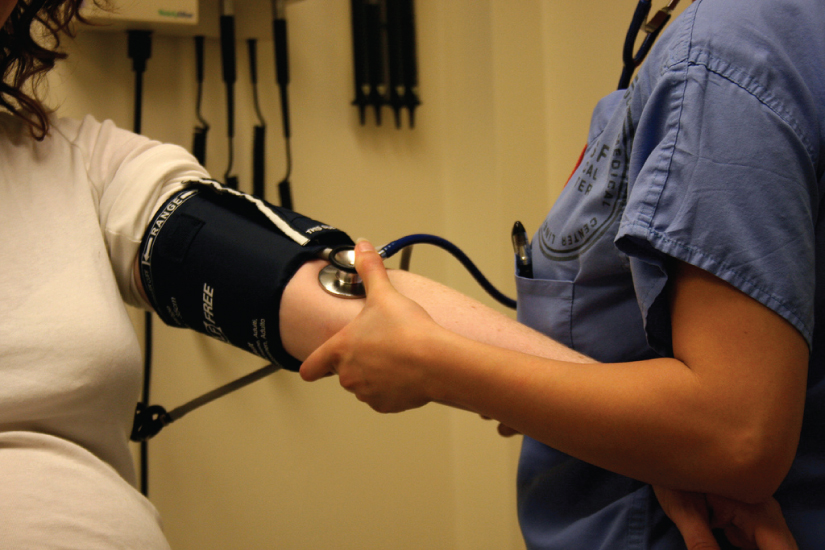
Chapter Goals
After finding out this chapter, it is possible for you to to:
- Evaluate and distinction the research of anatomy and physiology
- Describe the construction of the physique, from easiest to most advanced
- Outline homeostasis and clarify its significance to regular human functioning
- Use applicable anatomical terminology to establish key physique constructions, physique areas, and instructions within the physique
- Evaluate and distinction imaging strategies by way of their operate and use in finding out the human physique
Although it’s possible you’ll method a course in anatomy and physiology strictly as a requirement on your discipline of research, the data you acquire on this course will serve you nicely in lots of elements of your life. An understanding of anatomy and physiology isn’t solely elementary to any profession within the well being professions, however it may possibly additionally profit your personal well being. Familiarity with the human physique can assist you make healthful selections and immediate you to take applicable motion when indicators of sickness come up. Your data on this discipline will enable you perceive information about vitamin, medicines, medical units, procedures and enable you perceive genetic or infectious ailments. Sooner or later, everybody may have an issue with some facet of his or her physique and your data can assist you be a greater father or mother, partner, companion, good friend, colleague, or caregiver.
This chapter begins with an summary of anatomy and physiology and a preview of the physique areas and capabilities. It then covers the traits of life and the way the physique works to keep up steady circumstances. It introduces a set of ordinary phrases for physique constructions and for planes and positions within the physique that may function a basis for extra complete info lined later within the textual content. It ends with examples of medical imaging used to see contained in the dwelling human physique.
1.1 How Construction Determines Perform
Studying Goals
By the tip of this part, it is possible for you to to:
- Evaluate and distinction the research of anatomy and physiology
- Talk about the basic structure-function relationship between anatomy and physiology
Human anatomy is the scientific research of the physique’s constructions. A few of these constructions are very small and may solely be noticed and analyzed with the help of a microscope, whereas different, bigger constructions can readily be seen, manipulated, measured, and weighed. The phrase “anatomy” comes from the Greek root “ana” which implies “to chop aside” and “tomia” which implies “to chop.” Human anatomy was first studied by observing the outside of the physique, wounds of troopers, and different accidents. Later, physicians have been allowed to dissect our bodies of the useless to enhance their data. When a physique is dissected, its constructions are lower aside with a view to observe their bodily attributes and their relationships to 1 one other. Dissection continues to be utilized in medical colleges, anatomy programs, and in pathology labs. To be able to observe constructions in dwelling folks, nonetheless, numerous imaging strategies have been developed. These strategies enable clinicians to visualise constructions contained in the dwelling physique corresponding to a cancerous tumor or a fractured bone.
Like most scientific disciplines, anatomy has areas of specialization. Gross anatomy is the research of the bigger constructions of the physique, these seen with out assistance from magnification (picture under, Determine 1.1.1a). Gross and macro each imply “giant,” thus, gross anatomy can also be known as macroscopic anatomy. In distinction, micro means “small,” and microscopic anatomy is the research of constructions that may be noticed solely with using a microscope or different magnification units (picture under, Determine 1.1.1b). Microscopic anatomy contains cytology, the research of cells, and histology, the research of tissues. Because the know-how of microscopes has superior, anatomists have been capable of observe smaller and smaller constructions of the physique, from slices of enormous constructions like the center, to the three-dimensional constructions of enormous molecules within the physique.
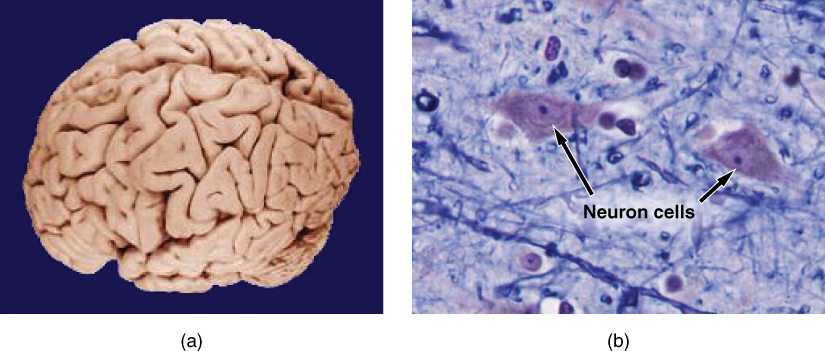
Anatomists take two normal approaches to the research of the physique’s constructions: regional and systemic. Regional anatomy is the research of the interrelationships of all the constructions in a particular physique area, such because the stomach. Finding out regional anatomy helps us admire the interrelationships of physique constructions, corresponding to how muscle mass, nerves, blood vessels, and different constructions work collectively to serve a selected physique area. In distinction, systemic anatomy is the research of the constructions that make up a discrete physique system—that’s, a bunch of constructions that work collectively to carry out a novel physique operate. For instance, a systemic anatomical research of the muscular system would take into account all the skeletal muscle mass of the physique.
Whereas anatomy is about construction, physiology is about operate. Human physiology is the scientific research of the chemistry and physics of the constructions of the physique and the methods wherein they work collectively to help the capabilities of life. A lot of the research of physiology facilities on the physique’s tendency towards homeostasis. Homeostasis is the state of regular inside circumstances maintained by dwelling issues. The research of physiology definitely contains remark, each with the bare eye and with microscopes, in addition to manipulations and measurements. Present advances in physiology normally rely upon rigorously designed laboratory experiments that reveal the capabilities of the numerous constructions and chemical compounds that make up the human physique.
Like anatomists, physiologists usually concentrate on a selected department of physiology. For instance, neurophysiology is the research of the mind, spinal twine, and nerves and the way these work collectively to carry out capabilities as advanced and numerous as imaginative and prescient, motion, and considering. Physiologists may fit from the organ degree (exploring, for instance, what completely different components of the mind does) to the molecular degree (corresponding to exploring how an electrochemical sign travels alongside nerves).
Type is intently associated to operate in all dwelling issues. For instance, the skinny flap of your eyelid can snap all the way down to clear away mud particles and nearly instantaneously slide again as much as mean you can see once more. On the microscopic degree, the association and performance of the nerves and muscle mass that serve the eyelid enable for its fast motion and retreat. At a smaller degree of research, the operate of those nerves and muscle mass likewise depends on the interactions of particular molecules and ions. Even the three-dimensional construction of sure molecules is crucial to their operate.
Your research of anatomy and physiology will make extra sense should you regularly relate the type of the constructions you’re finding out to their operate. The truth is, it may be considerably irritating to try to check anatomy with out an understanding of the physiology {that a} physique construction helps. Think about, for instance, making an attempt to understand the distinctive association of the bones of the human hand should you had no conception of the operate of the hand. Thankfully, your understanding of how the human hand manipulates instruments—from pens to cell telephones—helps you admire the distinctive alignment of the thumb in opposition to the 4 fingers, making your hand a construction that means that you can pinch and grasp objects and kind textual content messages.
Chapter Evaluate
Human anatomy is the scientific research of the physique’s constructions. Prior to now, anatomy has primarily been studied through observing accidents, and later by the dissection of anatomical constructions of cadavers, however previously century, computer-assisted imaging strategies have allowed clinicians to look contained in the dwelling physique. Human physiology is the scientific research of the chemistry and physics of the constructions of the physique. Physiology explains how the constructions of the physique work collectively to keep up life. It’s troublesome to check construction (anatomy) with out data of operate (physiology) and vice versa. The 2 disciplines are usually studied collectively as a result of kind and performance are intently associated in all dwelling issues.
1.2 Structural Group of the Human Physique
Studying Goals
By the tip of this part, it is possible for you to to:
- Describe the construction of the physique, from easiest to most advanced
- Describe the interrelationships between the organ techniques
Earlier than you start to check the completely different constructions and capabilities of the human physique, it’s useful to think about its primary structure; that’s, how its smallest components are assembled into bigger constructions. It’s handy to think about the constructions of the physique by way of elementary ranges of group that improve in complexity, corresponding to (from smallest to largest): chemical compounds, cells, tissues, organs, organ techniques, and an organism.
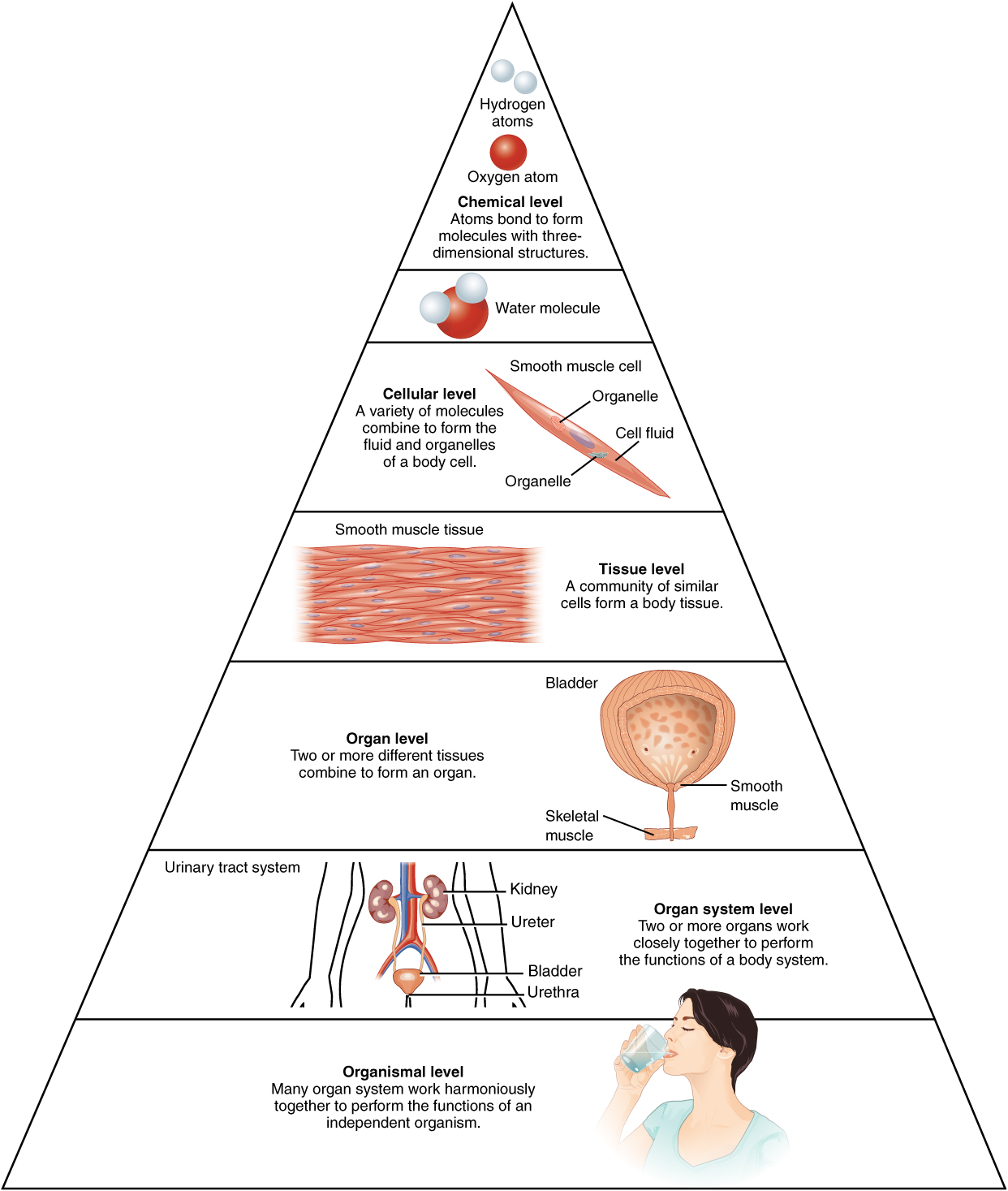
The group of the physique typically is mentioned by way of the distinct ranges of accelerating complexity, from the smallest chemical constructing blocks to a novel human organism.
The Ranges of Group
To check the chemical degree of group, scientists take into account the best constructing blocks of matter: subatomic particles, atoms and molecules. All matter within the universe consists of a number of distinctive pure substances referred to as parts. Examples of those parts are hydrogen, oxygen, carbon, nitrogen, calcium, and iron. The smallest unit of any of those pure substances (parts) is an atom. Atoms are made up of subatomic particles such because the proton, electron and neutron. Two or extra atoms mix to kind a molecule, such because the water molecules, proteins, and sugars present in dwelling issues. Molecules are the chemical constructing blocks of all physique constructions.
A cell is the smallest independently functioning unit of a dwelling organism. Single celled organisms, like micro organism, are extraordinarily small, independently-living organisms with a mobile construction. People are multicellular organisms with impartial cells working in live performance collectively. Every bacterium is a single cell. All dwelling constructions of human anatomy comprise cells, and nearly all capabilities of human physiology are carried out in cells or are initiated by cells.
A human cell usually consists of versatile membranes that enclose cytoplasm, a water-based mobile fluid, with quite a lot of tiny functioning items referred to as organelles. In people, as in all organisms, cells carry out all capabilities of life.
A tissue is a bunch of many related cells (although typically composed of some associated sorts) that work collectively to carry out a particular operate. An organ is an anatomically distinct construction of the physique composed of two or extra tissue sorts. Every organ performs a number of particular physiological capabilities. An organ system is a bunch of organs that work collectively to carry out main capabilities or meet physiological wants of the physique.
This ebook covers eleven distinct organ techniques within the human physique (Determine 1.2.2). Assigning organs to organ techniques will be imprecise since organs that “belong” to 1 system may also have capabilities integral to a different system. The truth is, most organs contribute to multiple system.

The organism degree is the very best degree of group. An organism is a dwelling being that has a mobile construction and that may independently carry out all physiologic capabilities essential for all times. In multi-cellular organisms, together with people, all cells, tissues, organs, and organ techniques of the physique work collectively to keep up the life and well being of the organism.
Chapter Evaluate
Life processes of the human physique are maintained at a number of ranges of structural group. These embrace the chemical, mobile, tissue, organ, organ system, and the organism degree. Larger ranges of group are constructed from decrease ranges. Subsequently, molecules mix to kind cells, cells mix to kind tissues, tissues mix to kind organs, organs mix to kind organ techniques, and organ techniques mix to kind organisms.
1.3 Homeostasis
Studying Goals
By the tip of this part, it is possible for you to to:
- Listing the elements of a homeostatically managed system
- Talk about the position of homeostasis within the human physique
- Distinction unfavorable and optimistic suggestions, giving one physiologic instance of every mechanism
Sustaining a steady system requires the physique to repeatedly monitor its inside circumstances. Although sure physiological techniques function inside incessantly bigger ranges, sure physique parameters are tightly managed homeostatically. For instance, physique temperature and blood stress are managed inside a really slender vary. A set level is the physiological worth round which the traditional vary fluctuates. For instance, the set level for typical human physique temperature is roughly 37°C (98.6°F). Physiological parameters, corresponding to physique temperature and blood stress, are likely to fluctuate inside a variety of some levels above and under that time. Receptors positioned within the physique’s key locations detect modifications from this set level and relay info to the management facilities positioned within the mind. The management facilities monitor and ship info to effector organs to regulate the physique’s response. If these effectors reverse the unique situation, the system is claimed to be regulated by unfavorable suggestions.

Management facilities within the mind and different components of the physique monitor and react to deviations from this set level utilizing unfavorable suggestions. Destructive suggestions is a mechanism that reverses a deviation from the set level, and in flip, maintains physique parameters inside their regular vary. The upkeep of homeostasis by unfavorable suggestions goes on all through the physique always and an understanding of unfavorable suggestions is thus elementary to an understanding of human physiology.
Destructive Suggestions
A unfavorable suggestions system has three primary elements: a sensor, management middle and an effector. (Determine 1.3.2a). A sensor, additionally referred to a receptor, displays a physiological worth, which is then reported to the management middle. The management middle compares the worth to the traditional vary. If the worth deviates an excessive amount of from the set level, then the management middle prompts an effector. An effector causes a change to reverse the state of affairs and return the worth to the traditional vary.

To be able to set the system in movement, a stimulus should drive a physiological parameter past its regular vary (that’s, past homeostasis). This stimulus is “heard” by a particular sensor. For instance, within the management of blood glucose, particular endocrine cells within the pancreas detect extra glucose (the stimulus) within the bloodstream. These pancreatic beta cells reply to the elevated degree of blood glucose by releasing the hormone (insulin) into the bloodstream. The insulin indicators skeletal muscle fibers, fats cells (adipocytes), and liver cells to take up the surplus glucose, eradicating it from the bloodstream. As glucose focus within the bloodstream drops, the lower in focus—the precise unfavorable suggestions—is detected by pancreatic alpha cells, and insulin launch stops. This prevents blood sugar ranges from persevering with to drop under the traditional vary.
People have an analogous temperature regulation suggestions system that works by selling both warmth loss or warmth acquire (Determine 1.3.2b). When the mind’s temperature regulation middle receives knowledge from the sensors indicating that the physique’s temperature exceeds its regular vary, it stimulates a cluster of mind cells known as the “heat-loss middle.” This stimulation has three main results:
- Blood vessels within the pores and skin start to dilate permitting extra blood from the physique core to movement to the floor of the pores and skin permitting the warmth to radiate into the surroundings.
- As blood movement to the pores and skin will increase, sweat glands are activated to extend their output. Because the sweat evaporates from the pores and skin floor into the encircling air, it takes warmth with it.
- The depth of respiration will increase, and an individual might breathe by an open mouth as an alternative of by the nasal passageways. This additional will increase warmth loss from the lungs.
In distinction, activation of the mind’s heat-gain middle by publicity to chilly reduces blood movement to the pores and skin, and blood getting back from the limbs is diverted right into a community of deep veins. This association traps warmth nearer to the physique core and restricts warmth loss. If warmth loss is extreme, the mind triggers a rise in random indicators to skeletal muscle mass, inflicting them to contract, producing shivering. The muscle contractions of shivering launch warmth whereas utilizing up ATP. The mind triggers the thyroid gland within the endocrine system to launch thyroid hormone, which will increase metabolic exercise and warmth manufacturing in cells all through the physique. The mind additionally indicators the adrenal glands to launch epinephrine (adrenaline), a hormone that causes the breakdown of glycogen into glucose, which can be utilized as an vitality supply. The breakdown of glycogen into glucose additionally leads to elevated metabolism and warmth manufacturing.
Optimistic Suggestions
Optimistic suggestions intensifies a change within the physique’s physiological situation relatively than reversing it. A deviation from the traditional vary leads to extra change, and the system strikes farther away from the traditional vary. Optimistic suggestions within the physique is regular solely when there’s a particular finish level. Childbirth and the physique’s response to blood loss are two examples of optimistic suggestions loops which can be regular however are activated solely when wanted.
Childbirth at full time period is an instance of a state of affairs wherein the upkeep of the present physique state isn’t desired. Monumental modifications within the mom’s physique are required to expel the child on the finish of being pregnant. The occasions of childbirth, as soon as begun, should progress quickly to a conclusion or the lifetime of the mom and the child are in danger. The intense muscular work of labor and supply are the results of a optimistic suggestions system (Determine 1.3.3).
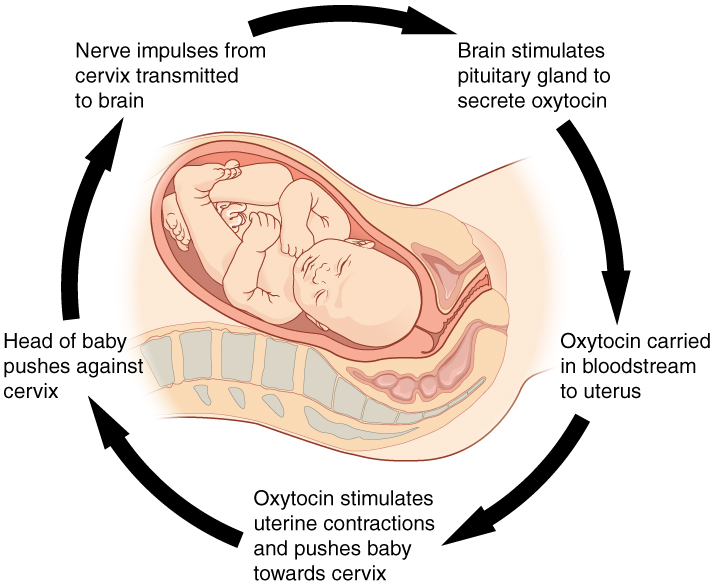
The primary contractions of labor (the stimulus) push the child towards the cervix (the bottom a part of the uterus). The cervix incorporates stretch-sensitive nerve cells that monitor the diploma of stretching (the sensors). These nerve cells ship messages to the mind, which in flip causes the pituitary gland on the base of the mind to launch the hormone oxytocin into the bloodstream. Oxytocin causes stronger contractions of the sleek muscle mass in of the uterus (the effectors), pushing the child additional down the beginning canal. This causes even larger stretching of the cervix. The cycle of stretching, oxytocin launch, and more and more extra forceful contractions stops solely when the child is born. At this level, the stretching of the cervix halts, stopping the discharge of oxytocin.
A second instance of optimistic suggestions facilities on reversing excessive injury to the physique. Following a penetrating wound, essentially the most fast risk is extreme blood loss. Much less blood circulating means decreased blood stress and decreased perfusion (penetration of blood) to the mind and different very important organs. If perfusion is severely decreased, very important organs will shut down and the particular person will die. The physique responds to this potential disaster by releasing substances within the injured blood vessel wall that start the method of blood clotting. As every step of clotting happens, it stimulates the discharge of extra clotting substances. This accelerates the processes of clotting and sealing off the broken space. Clotting is contained in a neighborhood space primarily based on the tightly managed availability of clotting proteins. That is an adaptive, life-saving cascade of occasions.
Chapter Evaluate
Homeostasis is the exercise of cells all through the physique to keep up the physiological state inside a slender vary that’s appropriate with life. Homeostasis is regulated by unfavorable suggestions loops and, a lot much less incessantly, by optimistic suggestions loops. Each have the identical elements of a stimulus, sensor, management middle, and effector; nonetheless, unfavorable suggestions loops work to stop an extreme response to the stimulus, whereas optimistic suggestions loops intensify the response till an finish level is reached.
1.4 Anatomical Terminology
Studying Goals
By the tip of this part, it is possible for you to to:
- Use applicable anatomical terminology to establish key physique constructions, physique areas, and instructions within the physique
- Reveal the anatomical place
- Describe the human physique utilizing directional and regional phrases
- Establish three planes mostly used within the research of anatomy
- Distinguish between main physique cavities
Anatomists and well being care suppliers use terminology that may be bewildering to the uninitiated; nonetheless, the aim of this language is to not confuse, however relatively to extend precision and cut back medical errors. For instance, is a scar “above the wrist” positioned on the forearm two or three inches away from the hand? Or is it on the base of the hand? Is it on the palm-side or back-side? By utilizing exact anatomical terminology, we eradicate ambiguity. For instance, you would possibly say a scar “on the anterior antebrachium 3 inches proximal to the carpus”. Anatomical phrases are derived from historical Greek and Latin phrases. As a result of these languages are not utilized in on a regular basis dialog, the that means of their phrases don’t change.
Anatomical phrases are made up of roots, prefixes, and suffixes. The basis of a time period typically refers to an organ, tissue, or situation, whereas the prefix or suffix typically describes the foundation. For instance, within the dysfunction hypertension, the prefix “hyper-” means “excessive” or “over,” and the foundation phrase “rigidity” refers to stress, so the phrase “hypertension” refers to abnormally hypertension.
Anatomical Place
To additional improve precision, anatomists standardize the way in which wherein they view the physique. Simply as maps are usually oriented with north on the high, the usual physique “map,” or anatomical place, is that of the physique standing upright, with the ft at shoulder width and parallel, toes ahead. The higher limbs are held out to every aspect, and the palms of the arms face ahead as illustrated in Determine 1.4.1. Utilizing this commonplace place reduces confusion. It doesn’t matter how the physique being described is oriented, the phrases are used as whether it is in anatomical place. For instance, a scar within the “anterior (entrance) carpal (wrist) area” can be current on the palm aspect of the wrist. The time period “anterior” can be used even when the hand have been palm down on a desk.
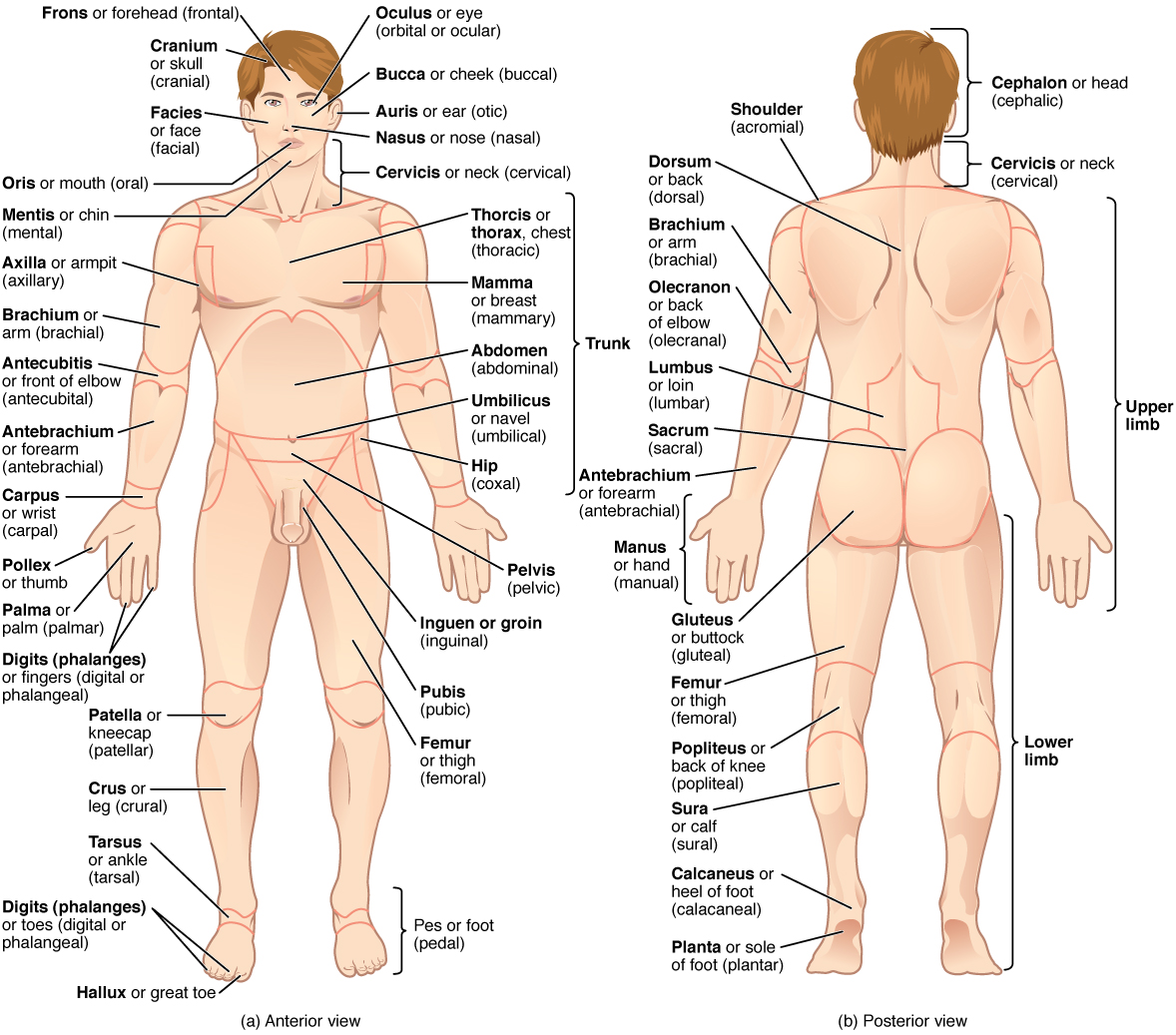
A physique that’s mendacity down is described as both susceptible or supine. Susceptible describes a face-down orientation, and supine describes a face up orientation. These phrases are typically utilized in describing the place of the physique throughout particular bodily examinations or surgical procedures.
Regional Phrases
The human physique’s quite a few areas have particular phrases to assist improve precision (see Determine 1.4.1). Discover that the time period “brachium” or “arm” is reserved for the “higher arm” and “antebrachium” or “forearm” is used relatively than “decrease arm.” Equally, “femur” or “thigh” is appropriate, and “leg” or “crus” is reserved for the portion of the decrease limb between the knee and the ankle. It is possible for you to to explain the physique’s areas utilizing the phrases from the determine.
Directional Phrases
Sure directional anatomical phrases seem all through this and another anatomy textbook (Determine 1.4.2). These phrases are important for describing the relative areas of various physique constructions. As an illustration, an anatomist would possibly describe one band of tissue as “inferior to” one other or a doctor would possibly describe a tumor as “superficial to” a deeper physique construction. Commit these phrases to reminiscence to keep away from confusion if you find yourself finding out or describing the areas of explicit physique components.
- Anterior (or ventral) describes the entrance or route towards the entrance of the physique. The toes are anterior to the foot.
- Posterior (or dorsal) describes the again or route towards the again of the physique. The popliteus is posterior to the patella.
- Superior (or cranial) describes a place above or increased than one other a part of the physique correct. The orbits are superior to the oris.
- Inferior (or caudal) describes a place under or decrease than one other a part of the physique correct; close to or towards the tail (in people, the coccyx, or lowest a part of the spinal column). The pelvis is inferior to the stomach.
- Lateral describes the aspect or route towards the aspect of the physique. The thumb (pollex) is lateral to the digits.
- Medial describes the center or route towards the center of the physique. The hallux is the medial toe.
- Proximal describes a place in a limb that’s nearer to the purpose of attachment or the trunk of the physique. The brachium is proximal to the antebrachium.
- Distal describes a place in a limb that’s farther from the purpose of attachment or the trunk of the physique. The crus is distal to the femur.
- Superficial describes a place nearer to the floor of the physique. The pores and skin is superficial to the bones.
- Deep describes a place farther from the floor of the physique. The mind is deep to the cranium.
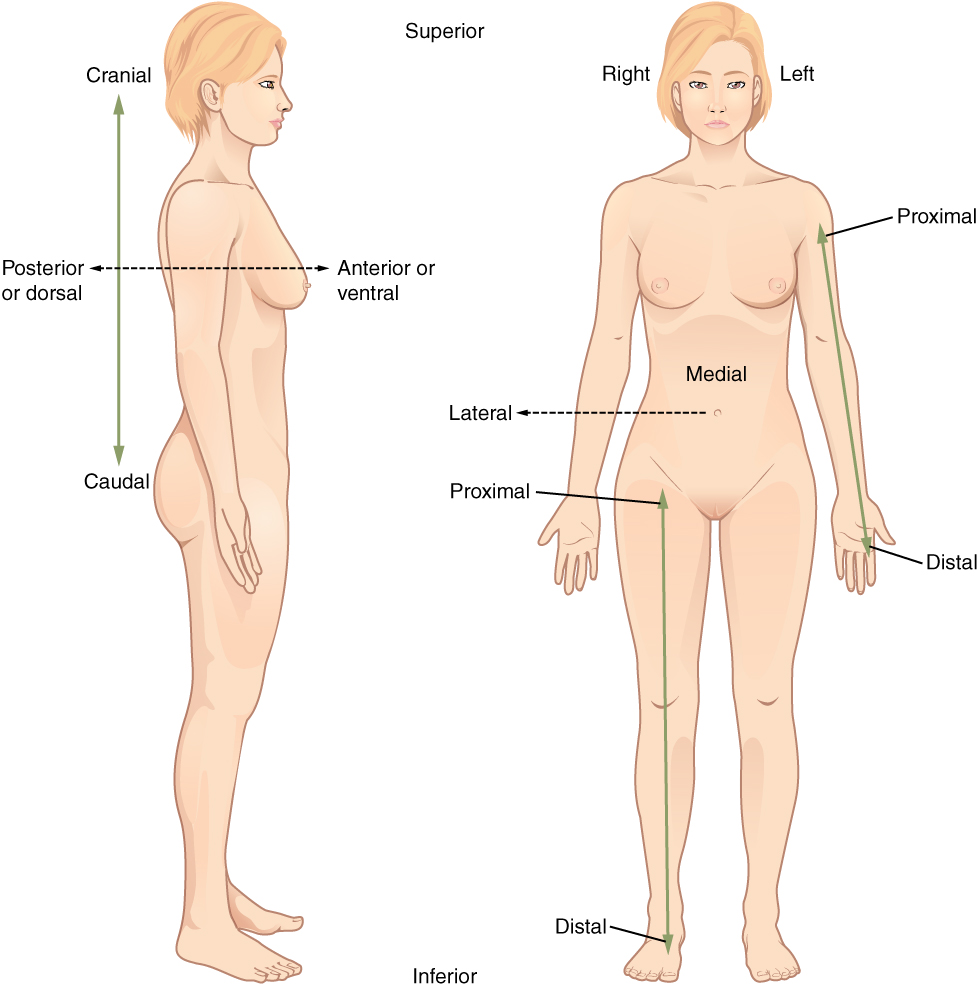
Physique Planes
A part is a two-dimensional floor of a three-dimensional construction that has been lower. Trendy medical imaging units allow clinicians to acquire “digital sections” of dwelling our bodies. We name these scans. Physique sections and scans will be appropriately interpreted, provided that the viewer understands the aircraft alongside which the part was made. A aircraft is an imaginary, two-dimensional floor that passes by the physique. There are three planes generally referred to in anatomy and medication, as illustrated in Determine 1.4.3.
- The sagittal aircraft divides the physique or an organ vertically into proper and left sides. If this vertical aircraft runs straight down the center of the physique, it’s referred to as the midsagittal or median aircraft. If it divides the physique into unequal proper and left sides, it’s referred to as a parasagittal aircraft or much less generally a longitudinal part.
- The frontal aircraft divides the physique or an organ into an anterior (entrance) portion and a posterior (rear) portion. The frontal aircraft is sometimes called a coronal aircraft. (“Corona” is Latin for “crown.”)
- The transverse (or horizontal) aircraft divides the physique or organ horizontally into higher and decrease parts. Transverse planes produce pictures known as cross sections.
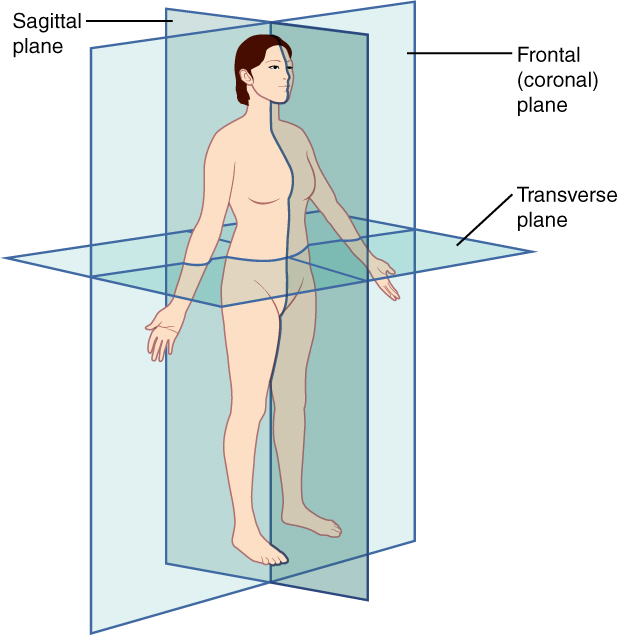
Physique Cavities
The physique maintains its inside group by way of membranes, sheaths, and different constructions that separate compartments. The principle cavities of the physique embrace the cranial, thoracic and abdominopelvic (also referred to as the peritoneal) cavities. The cranial bones create the cranial cavity the place the mind sits. The thoracic cavity is enclosed by the rib cage and incorporates the lungs and the center, which is positioned within the mediastinum. The diaphragm varieties the ground of the thoracic cavity and separates it from the extra inferior abdominopelvic/peritoneal cavity. The abdominopelvic/peritoneal cavity is the biggest cavity within the physique. Though no membrane bodily divides the abdominopelvic cavity, it may be helpful to differentiate between the belly cavity, (the division that homes the digestive organs), and the pelvic cavity, (the division that homes the organs of copy).
Belly Areas and Quadrants
To advertise clear communication, as an example, concerning the location of a affected person’s belly ache or a suspicious mass, well being care suppliers usually divide up the cavity into both 9 areas or 4 quadrants (Determine 1.4.4).
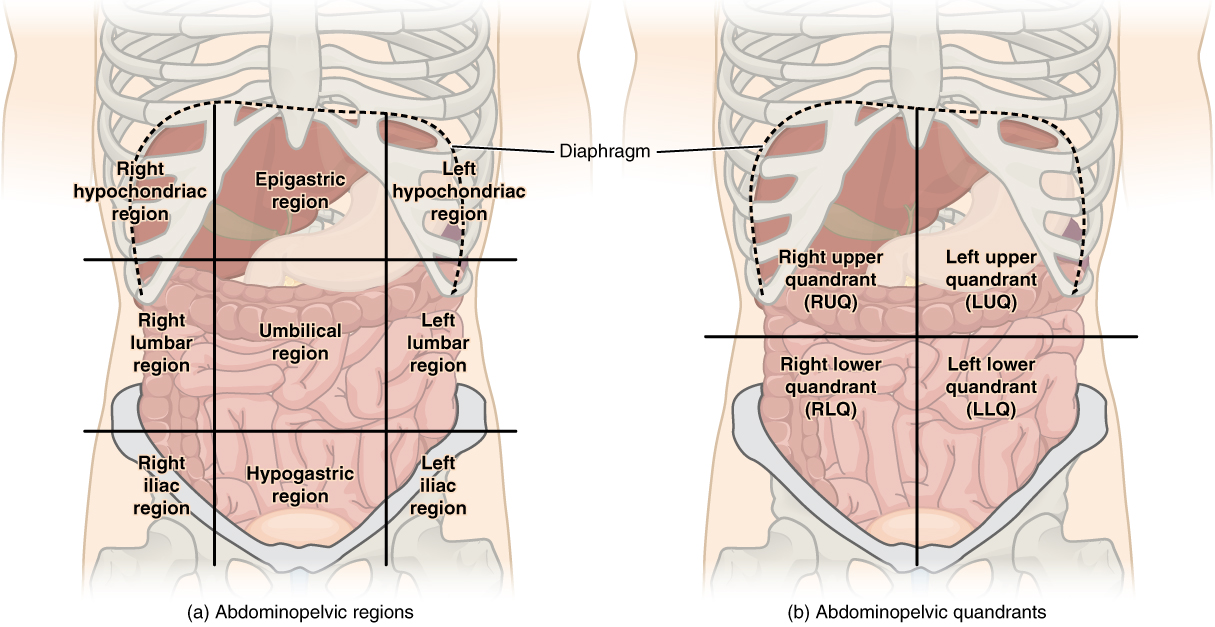
The extra detailed regional method subdivides the cavity with one horizontal line instantly inferior to the ribs and one instantly superior to the pelvis, and two vertical strains drawn as if dropped from the midpoint of every clavicle (collarbone). There are 9 ensuing areas. The easier quadrants method, which is extra generally utilized in medication, subdivides the cavity with one horizontal and one vertical line that intersect on the affected person’s umbilicus (navel).
Chapter Evaluate
Historical Greek and Latin phrases are used to construct anatomical phrases. An ordinary reference place for mapping the physique’s constructions is the traditional anatomical place. Areas of the physique are recognized utilizing phrases corresponding to “occipital” which can be extra exact than frequent phrases and phrases corresponding to “the again of the pinnacle.” Directional phrases corresponding to anterior and posterior are important for precisely describing the relative areas of physique constructions. Photos of the physique’s inside generally align alongside one among three planes: the sagittal, frontal, or transverse.
1.5 Medical Imaging
Studying Goals
By the tip of this part, it is possible for you to to:
- Evaluate and distinction medical imaging strategies by way of their operate and use in finding out the human physique
For hundreds of years, concern of the useless and authorized sanctions restricted the power of anatomists and physicians to check the inner constructions of the human physique. An incapacity to regulate bleeding, an infection, and ache made surgical procedures rare, and those who have been carried out—corresponding to wound suturing, amputations, tooth and tumor removals, cranium drilling, and cesarean births—didn’t tremendously advance data about inside anatomy. Theories concerning the operate of the physique and about illness have been subsequently largely primarily based on exterior observations and creativeness. In the course of the fourteenth and fifteenth centuries, nonetheless, the detailed anatomical drawings of Italian artist and anatomist Leonardo da Vinci and Flemish anatomist Andreas Vesalius have been printed, and curiosity in human anatomy started to extend. Medical colleges started to show anatomy utilizing human dissection; some resorted to grave robbing to acquire corpses. Legal guidelines have been ultimately handed that enabled college students to dissect the corpses of criminals and those that donated their our bodies for analysis. Nonetheless, it was not till the late nineteenth century that medical researchers found non-surgical strategies to look contained in the dwelling physique.
X-Rays
German physicist Wilhelm Röntgen (1845–1923) was experimenting with electrical present when he found {that a} mysterious and invisible “ray” would move by his flesh however depart a top level view of his bones on a display screen coated with a steel compound. In 1895, Röntgen made the primary sturdy report of the inner components of a dwelling human: an “X-ray” picture (because it got here to be referred to as) of his spouse’s hand. Scientists world wide shortly started their very own experiments with X-rays, and by 1900, X-rays have been broadly used to detect quite a lot of accidents and ailments. In 1901, Röntgen was awarded the primary Nobel Prize for physics for his work on this discipline.
The X-ray is a type of excessive vitality electromagnetic radiation with a brief wavelength able to penetrating solids and ionizing gases. As they’re utilized in medication, X-rays are emitted from an X-ray machine and directed towards a specifically handled metallic plate positioned behind the affected person’s physique. The beam of radiation leads to darkening of the X-ray plate. X-rays are barely impeded by smooth tissues, which present up as grey on the X-ray plate, whereas onerous tissues, corresponding to bone, largely block the rays, producing a light-toned “shadow.” Thus, X-rays are greatest used to visualise onerous physique constructions corresponding to enamel and bones (Determine 1.5.1). Like many types of excessive vitality radiation, nonetheless, X-rays are able to damaging cells and initiating modifications that may result in most cancers. This hazard of extreme publicity to X-rays was not absolutely appreciated for a few years after their widespread use.

Refinements and enhancements of X-ray strategies have continued all through the 20th and twenty-first centuries. Though typically supplanted by extra subtle imaging strategies, the X-ray stays a “workhorse” in medical imaging, particularly for viewing fractures and for dentistry. The drawback of irradiation to the affected person and the operator is now attenuated by correct shielding and by limiting publicity.
Trendy Medical Imaging
X-rays can depict a two-dimensional picture of a physique area, and solely from a single angle. In distinction, more moderen medical imaging applied sciences produce knowledge that’s built-in and analyzed by computer systems to provide three-dimensional pictures or pictures that reveal elements of the physique functioning.
Computed Tomography
Tomography refers to imaging by sections. Computed tomography (CT) is a noninvasive imaging method that makes use of computer systems to research a number of cross-sectional X-rays with a view to reveal minute particulars about constructions within the physique (Determine 1.5.2a). The method was invented within the Nineteen Seventies and relies on the precept that, as X-rays move by the physique, they’re absorbed or mirrored at completely different ranges. Within the method, a affected person lies on a motorized platform whereas a computerized axial tomography (CAT) scanner rotates 360 levels across the affected person, taking X-ray pictures. A pc combines these pictures right into a two-dimensional view of the scanned space, or “slice.”
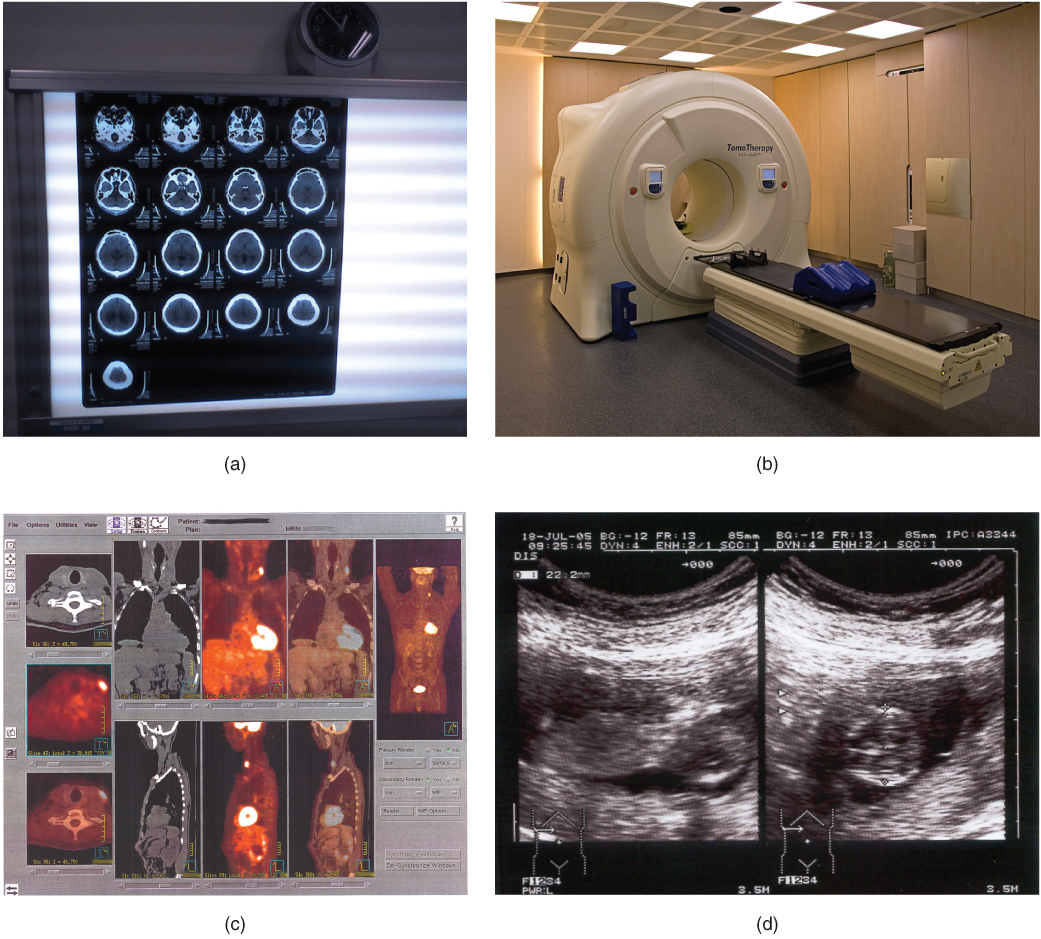
Since 1970, the event of extra highly effective computer systems and extra subtle software program has made CT scanning routine for a lot of kinds of diagnostic evaluations. It’s particularly helpful for smooth tissue scanning, corresponding to of the mind and the thoracic and belly viscera. Its degree of element is so exact that it may possibly enable physicians to measure the dimensions of a mass all the way down to a millimeter. The principle drawback of CT scanning is that it exposes sufferers to a dose of radiation many occasions increased than that of X-rays. The truth is, youngsters who bear CT scans are at elevated danger of growing most cancers, as are adults who’ve a number of CT scans.
Magnetic Resonance Imaging
Magnetic resonance imaging (MRI) is a noninvasive medical imaging method primarily based on a phenomenon of nuclear physics found within the Nineteen Thirties, wherein matter uncovered to magnetic fields and radio waves was discovered to emit radio indicators. In 1970, a doctor and researcher named Raymond Damadian seen that malignant (cancerous) tissue gave off completely different indicators than regular physique tissue. He utilized for a patent for the primary MRI scanning system, which was in use clinically by the early Eighties. The early MRI scanners have been crude, however advances in digital computing and electronics led to their development over another method for exact imaging, particularly to find tumors. MRI additionally has the main benefit of not exposing sufferers to radiation.
Drawbacks of MRI scans embrace their a lot increased value, and affected person discomfort with the process. The MRI scanner topics the affected person to such highly effective electromagnets that the scan room have to be shielded. The affected person have to be enclosed in a steel tube-like system during the scan (see Figure 1.5.2b), typically so long as thirty minutes, which will be uncomfortable and impractical for ailing sufferers. The system can also be so noisy that, even with earplugs, sufferers can turn out to be anxious and even fearful. These issues have been overcome considerably with the event of “open” MRI scanning, which doesn’t require the affected person to be totally enclosed within the steel tube. Sufferers with iron-containing metallic implants (inside sutures, some prosthetic units, and so forth) can’t bear MRI scanning as a result of it may possibly dislodge these implants.
Practical MRIs (fMRIs), which detect the focus of blood movement in sure components of the physique, are more and more getting used to check the exercise in components of the mind throughout varied physique actions. This has helped scientists be taught extra concerning the areas of various mind capabilities, abnormalities, and ailments.
Positron Emission Tomography
Positron emission tomography (PET) is a medical imaging method involving using so-called radiopharmaceuticals, substances that emit radiation that’s short-lived and subsequently comparatively secure to manage to the physique. Though the primary PET scanner was launched in 1961, it took 15 extra years earlier than radiopharmaceuticals have been mixed with the method and revolutionized its potential. The principle benefit is that PET (see Figure 1.5.2c) can illustrate physiologic exercise—together with nutrient metabolism and blood movement—of the organ or organs being focused, whereas CT and MRI scans can solely present static pictures. PET is broadly used to diagnose a mess of circumstances, corresponding to coronary heart illness, the unfold of most cancers, sure types of an infection, mind abnormalities, bone illness, and thyroid illness.
Ultrasonography
Ultrasonography is an imaging method that makes use of the transmission of high-frequency sound waves into the physique to generate an echo sign that’s transformed by a pc right into a real-time picture of anatomy and physiology (see Determine 1.5.2d). Ultrasonography is the least invasive of all imaging strategies, and it’s subsequently used extra freely in delicate conditions corresponding to being pregnant. The know-how was first developed within the Forties and Nineteen Fifties. Ultrasonography is used to check coronary heart operate, blood movement within the neck or extremities, sure circumstances corresponding to gallbladder illness, and fetal progress and improvement. The principle disadvantages of ultrasonography are that the picture high quality is closely operator-dependent and that it’s unable to penetrate bone and fuel.
Microscopy
Microscopy isn’t an imaging method, however relatively a method to view a small pattern of tissue faraway from the human physique. When there’s a drawback in a particular physique tissue, a doctor can take away a pattern of the tissue from the physique and put together it as a microscope slide. The doctor can then view constructions not seen with the bare eye. Generally used microscope strategies embrace mild microscopy, scanning electron microscopy (SEM), and transmission electron microscopy (TEM). Tissue samples utilized in mild microscopy are usually stained utilizing colourful dyes to reinforce distinction as varied components of the cells take up dye otherwise. Mild microscopes usually amplify roughly 10x to 1000x. In distinction, SEM can amplify as much as 500,000x and TEM can amplify as much as 10,000,000x. Each SEM and TEM use electron waves relatively than mild to amplify a pattern. SEM offers a 3D picture of the pattern floor, whereas TEM offers a excessive decision picture from an ultra-thin pattern.
Chapter Evaluate
Detailed anatomical drawings of the human physique first grew to become obtainable within the fifteenth and sixteenth centuries; nonetheless, it was not till the tip of the nineteenth century, and the invention of X-rays, that anatomists and physicians found non-surgical strategies to look inside a dwelling physique. Since then, many different strategies, together with CT scans, MRI scans, PET scans, ultrasonography, and superior microscopy strategies have been developed, offering extra correct and detailed views of the human physique’s kind and performance.